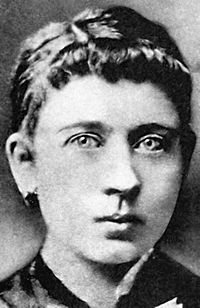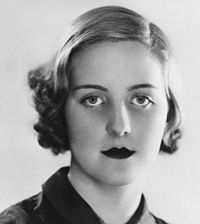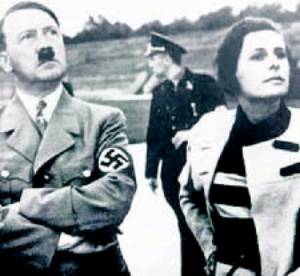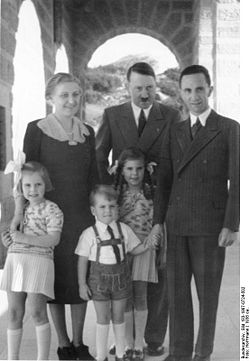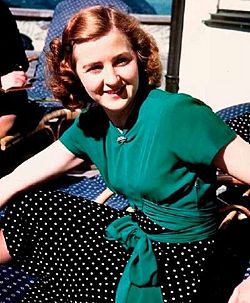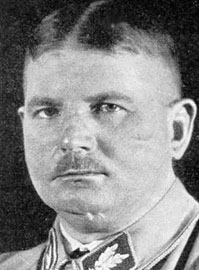Hitler and his personal life: Difference between revisions
imported>Howard C. Berkowitz No edit summary |
imported>Howard C. Berkowitz No edit summary |
||
| Line 19: | Line 19: | ||
[[Image:KlaraHitler.jpg|left|thumb|200px|Klara, Hitler's mother]] | [[Image:KlaraHitler.jpg|left|thumb|200px|Klara, Hitler's mother]] | ||
==Mother== | ==Mother and boyhood== | ||
While he did not follow her desires for him to learn a trade or further his education, Hitler was extremely close to his mother, Klara. Her physician told Hitler her "death had been a savior" from her pain, but said "In all my career, I never saw anyone so prostrate with grief as Adolf Hitler." <ref>{{citation | While he did not follow her desires for him to learn a trade or further his education, Hitler was extremely close to his mother, Klara. Her physician told Hitler her "death had been a savior" from her pain, but said "In all my career, I never saw anyone so prostrate with grief as Adolf Hitler." <ref>{{citation | ||
| author = [[John Toland]] | | author = [[John Toland]] | ||
| Line 25: | Line 25: | ||
|publisher = Doubleday | year = 1976}}, pp. 25-27</ref> | |publisher = Doubleday | year = 1976}}, pp. 25-27</ref> | ||
His one boyhood friend, [[August Kubizek]], said "he saw everywhere only obstacles and hostility....He was always up against something and at odds with the world...I never saw him take anything lightly." While he rejected formal education, Kubizek said he was always surrounded by books, especially on German history and mythology. <ref name=S14>{{citation | |||
| author = William Shirer | |||
| title = The Rise and Fall of the Third Reich | |||
| publisher = Simon & Schuster | |||
| year = 1960}}, pp. 15-16</ref> | |||
Kubizek and Klara did not hear from Adolf after he first [[Hitler in Vienna|moved to Vienna]]. She disapproved of his withdrawing his inheritance to study, and she said she had become an "old, sick woman."<ref>{{citation | |||
| title = Adolf Hitler | |||
| author = [[John Toland]] | |||
| publisher = Doubleday | year = 1976}}, p. 25</ref> He did not initially tell his family, since they had agreed to let him go to Vienna to enter the Academy. If he told them, there would be pressure either to apprentice for a trade, or to study for the civil service. | |||
She developed [[breast cancer]] in 1907, and was treated by Dr. Edward Bloch, a Jewish physician to whom Hitler paid much respect. After heroic but unsuccessful treatment, she died in 1908. The surgical wound had been treated locally with strong-smelling [[iodoform]], which left a lifelong impression. He returned from Vienna to care for her in her last days, during which she was to whisper to Kubizek, "Gustl, go on being a good friend to my son when I'm no longer here. He has no one else." | |||
Hitler was to send respectful greetings to Bloch for years. In 1937, he said to fellow Nazis, "Dr. Bloch," said Hitler, "is an Edaljude - a noble Jew. If all Jews were like him, there would be no Jewish question." <ref name=OSSBloch2>{{citation | |||
| journal = [[Office of Strategic Services]]: Hitler Source Book | |||
| title = Interview With Dr. Eduard Bloch (Part 2 of 2) | |||
|date = 5 March 1943 | |||
| url = http://www.nizkor.org/hweb/people/h/hitler-adolf/oss-papers/text/oss-sb-bloch-02.html}}</ref> | |||
==Adult relationships with women== | ==Adult relationships with women== | ||
| Line 58: | Line 76: | ||
==Relationships with men== | ==Relationships with men== | ||
He also lacked close relationships with men; perhaps the closest were with two very different personalities, [[Ernst Roehm]] and [[Albert Speer]]. | He also lacked close relationships with men; perhaps the closest were with two very different personalities, [[Ernst Roehm]] and [[Albert Speer]]. | ||
===Vienna friendships=== | |||
In February 1910, from homelessness, he was guided by a friend he met there, [[Reinhold Hanisch]], he was guided into a beginning of self-respect, after receiving funds from his sister.<ref>{{citation | |||
| author = Reinhold Hanisch | |||
| title = "I Was Hitler's Buddy" | |||
| journal = New Republic | date = April 1939 | |||
| pages = 193-99, 270-72, 297-300 | |||
| url = http://www.history.ucsb.edu/faculty/marcuse/projects/hitler/sources/30s/394newrep/394NewRepHanischHitlersBuddy.htm | |||
}}</ref> While taking part in political arguments at the dormitory, Hanisch said "When he got excited, Hitler couldn't restrain himself. He screamed and fidgeted with his hands. But when he was quiet, he seemed to have a fair amount of self-control and acted in quite a dignified manner." Hanisch remembered only one anti-Semitic comment, and that Hitler spoke of gratitude to Jewish charities, admiration for Jewish resistance to persecution; his friend believes his strong for Jews, which he claims, in ''Mein Kampf'', formed in Vienna, developed later. <ref>Shirer, pp. 43-45</ref> | |||
[[Image:Ernst Roehm.jpg|left|right|200px|Ernst Roehm]] | [[Image:Ernst Roehm.jpg|left|right|200px|Ernst Roehm]] | ||
Later, he would accuse Hanisch, in court, of cheating him, and break the relationship. Some believe the fraud charges were falsified as a way to break up a too-close relationship in which Hitler was not dominant. | |||
===Ernst Roehm=== | ===Ernst Roehm=== | ||
When he joined the early party, he became very close to Roehm, who was the only person with whom he was on a first-name basis, and was a "Duzfreund" -- a friend with whom he used the intimate second-person pronoun, "du". [[Joachim Fest]], a German journalist and biographer of Hitler, called the bloody ending, in the 1934 [[Night of the Long Knives]], perhaps the "only instance of [classic] tragedy in Hitler's life." Roehm and Hitler were once close friends, but had become rivals. Hitler saw the need to grow the Nazis beyond the original core of the "Brown Revolution", making alliances with the capitalists and industrialists of the German right, as well as the Army. Roehm "had obligations to the dynamism and the unsatisfied cravings of his millions of followers." <ref>{{citation | When he joined the early party, he became very close to Roehm, who was the only person with whom he was on a first-name basis, and was a "Duzfreund" -- a friend with whom he used the intimate second-person pronoun, "du". [[Joachim Fest]], a German journalist and biographer of Hitler, called the bloody ending, in the 1934 [[Night of the Long Knives]], perhaps the "only instance of [classic] tragedy in Hitler's life." Roehm and Hitler were once close friends, but had become rivals. Hitler saw the need to grow the Nazis beyond the original core of the "Brown Revolution", making alliances with the capitalists and industrialists of the German right, as well as the Army. Roehm "had obligations to the dynamism and the unsatisfied cravings of his millions of followers." <ref>{{citation | ||
| Line 69: | Line 96: | ||
Hitler enjoyed fast cars, and was close to his chauffeurs, [[Emil Maurice]], Julius Schreck, and Eric Kempka; they enjoyed a far higher status than servants. | Hitler enjoyed fast cars, and was close to his chauffeurs, [[Emil Maurice]], Julius Schreck, and Eric Kempka; they enjoyed a far higher status than servants. | ||
===Access to social circles=== | ===Access to social circles=== | ||
In 1923, he met [[Ernst Hanfstaengl|Ernst "Putzi" Hanfstaengel]], half-American, who had attended Harvard. He was one of Hitler's entries to the "good families" of Munich. More importantly on a personal level, his piano playing and his humor relaxed Hitler. <ref | In 1923, he met [[Ernst Hanfstaengl|Ernst "Putzi" Hanfstaengel]], half-American, who had attended Harvard. He was one of Hitler's entries to the "good families" of Munich. More importantly on a personal level, his piano playing and his humor relaxed Hitler. <ref>Shirer, pp. 46-47</ref> He would become an early Nazi press chief, but later break with Hitler and flee to the West, where he was a source on Hitler's personality for U.S. intelligence. | ||
===Albert Speer=== | ===Albert Speer=== | ||
{{main|Albert Speer}} | {{main|Albert Speer}} | ||
Revision as of 17:54, 9 January 2011
In attempting to explain Hitler's motivation, many historians and social scientists have looked at his personal relationships. He had few if any equal friendships, or, as with Ernst Roehm, or less lethally with Reinhold Hanisch or Emil Maurice. The man that could captivate masses and work his will on individuals apparently had great difficulty in relaxing, unless he controlled the situation.
There is no consensus either on how they affected him or what his true sexuality may have been. Kershaw, drawing in part from Kubizek, suggests he was prudish and offended by sexuality of all types, which could well have been based on von Schenerer's principles. He met with "cold indifference" flirtation from young women, was repelled by homosexuality, refrained from masturbation, and was horrified but fascinated by prostitution. [1] He was terrified by venereal disease, a theme that recurred in Mein Kampf.
Machtan calls him a homosexual, although agreeing there is little positive evidence he had sex with men, but more that he did not have sex with women. [2] Langer, in the U.S. intelligence psychological profile, believed he was heterosexual, although obsessed with paraphilias. It is, however, reasonably well established that he never had a close adult romantic relationship.
Mother and boyhood
While he did not follow her desires for him to learn a trade or further his education, Hitler was extremely close to his mother, Klara. Her physician told Hitler her "death had been a savior" from her pain, but said "In all my career, I never saw anyone so prostrate with grief as Adolf Hitler." [3]
His one boyhood friend, August Kubizek, said "he saw everywhere only obstacles and hostility....He was always up against something and at odds with the world...I never saw him take anything lightly." While he rejected formal education, Kubizek said he was always surrounded by books, especially on German history and mythology. [4]
Kubizek and Klara did not hear from Adolf after he first moved to Vienna. She disapproved of his withdrawing his inheritance to study, and she said she had become an "old, sick woman."[5] He did not initially tell his family, since they had agreed to let him go to Vienna to enter the Academy. If he told them, there would be pressure either to apprentice for a trade, or to study for the civil service.
She developed breast cancer in 1907, and was treated by Dr. Edward Bloch, a Jewish physician to whom Hitler paid much respect. After heroic but unsuccessful treatment, she died in 1908. The surgical wound had been treated locally with strong-smelling iodoform, which left a lifelong impression. He returned from Vienna to care for her in her last days, during which she was to whisper to Kubizek, "Gustl, go on being a good friend to my son when I'm no longer here. He has no one else."
Hitler was to send respectful greetings to Bloch for years. In 1937, he said to fellow Nazis, "Dr. Bloch," said Hitler, "is an Edaljude - a noble Jew. If all Jews were like him, there would be no Jewish question." [6]
Adult relationships with women
He appeared to enjoy the company of attractive women, but was awkward in starting relationships. Of the women to whom he was close, Eva Braun and Geli Rabaul committed suicide, while Unity Mitford and Mimi Reiter attempted it. There was "gossip" he had relationships with Leni Riefenstahl and actresses Olga Tscechowa, Lil Dagover and Pola Negri. Shirer observed that he sought the "stimulation his suppressed bohemian nature craved," rather than sex. [7]
Unity Mitford
Unity Mitford, the British daughter of Lord Redesdale, was an art student in Germany, who became a Nazi as soon as she met Hitler. Different than other women he knew, she was extremely free in his speech, quite blunt to him at times. [7]

Geli Rabaul
His niece, Geli was his great love, although it is not at all clear that the intensity was reciprocal. They probably first met in the summer of 1924, when Angela Raubal visited her half-brother Adolf, bringing 16-year-old Geli. She graduated from high school in 1927, and visited him on a school trip; he later took her, along with her mother and a girlfriend, on a road trip. Rudolf Hess called her a "tall, pretty girl of nineteen...always cheerful and as little at a loss as her uncle...the latter is hardly a match for her ready tongue." [8]
Alan Bullock wrote "This period in Munich Hitler later described as the happiest in his life; he idolised this girl, who was twenty years younger than himself, took her with him whenever he could - in short, he fell in love with her...She was flattered and impressed by her now famous uncle, she enjoyed going about with him, but she suffered from his hypersensitive jealousy."
She was to die, under questionable circumstances, in September 1931. It is most often considered a suicide by gunshot. Hitler himself was far away and could not have killed her, but it has been suggested by some that he ordered her death.
Contrasting her to Eva Braun, he told his secretary, Christa Schroeder, "Eva is very nice, but in my life, ony Geli could have inspired in me genuine passion. I can never think of marrying Eva.The only woman I could have tied myself to for life was Geli."[9]
Leni Riefenstahl
With other, stronger women, such as Leni Riefenstahl, he kept a distance. Riefenstahl, a distinguished cinematographer, actress and photographer, had a far stronger personality than Braun or Raubal. The two were taking a leisurely seaside walk in May 1932, which she describes as
Quite relaxed, Hitler spoke of his private life and of things that particularly interested him. Foremost among them were architecture and music — he spoke of Wagner, King Ludwig, and Bayreuth. After he had talked of them for a while, his expression and voice suddenly changed. Fervently, he said "But what fulfills me more than anything else is my political mission. I feel it is my vocation to save Germany — I cannot and may not evade it"...It was dark, and I could no longer see the men behind us. After a long pause he came to a halt, gave me a lingering look, slowly put his arms around me, and drew me to him....He looked at me excitedly When he saw how averse I was he at once let go of me. He turned away a little. Then I saw him raise his hands and say imploringly, "I cannot love any women until I have completed my task."[10]
Magda Goebbels
Women, such as Magda Quandt Goebbels, would also fixate on him, and she chose to die with him, killing her children. While working as Goebbels' secretary (and lover) in the fall of 1931, she called on Hitler, and both experienced strong emotions. She would tell Riefenstahl that she was in love with him, but, "It was not until I realized that, discounting his niece Geli,Hitler cannot love any woman, but only, as he always says, 'his Germany', that I consented to marry Dr. Goebbels, because now I can be near the Fuehrer." After the marriage, she said "We like to think of this [i.e., our] apartment as his second home. Hitler now had the "devotion, admration and solicitude of a charming woman without having to commit himself in any way." He could use Geli's death to say he had "overcome the urge to overcome a woman physically."[11]
Eva Braun
Eva Braun was his longest adult relationship. An assistant to his photograper, Hans Hoffman, he saw both Eva and Geli in the same time period, contributing to Geli's tensions.
They finally married just before their joint suicide in Hitler's bunker. Prior to that, she had long been his companion, but known only to his personal staff. After Hitler once made a public statement that he had no private life, she quipped "just call me Miss No Private Life."
Relationships with men
He also lacked close relationships with men; perhaps the closest were with two very different personalities, Ernst Roehm and Albert Speer.
Vienna friendships
In February 1910, from homelessness, he was guided by a friend he met there, Reinhold Hanisch, he was guided into a beginning of self-respect, after receiving funds from his sister.[12] While taking part in political arguments at the dormitory, Hanisch said "When he got excited, Hitler couldn't restrain himself. He screamed and fidgeted with his hands. But when he was quiet, he seemed to have a fair amount of self-control and acted in quite a dignified manner." Hanisch remembered only one anti-Semitic comment, and that Hitler spoke of gratitude to Jewish charities, admiration for Jewish resistance to persecution; his friend believes his strong for Jews, which he claims, in Mein Kampf, formed in Vienna, developed later. [13]
Later, he would accuse Hanisch, in court, of cheating him, and break the relationship. Some believe the fraud charges were falsified as a way to break up a too-close relationship in which Hitler was not dominant.
Ernst Roehm
When he joined the early party, he became very close to Roehm, who was the only person with whom he was on a first-name basis, and was a "Duzfreund" -- a friend with whom he used the intimate second-person pronoun, "du". Joachim Fest, a German journalist and biographer of Hitler, called the bloody ending, in the 1934 Night of the Long Knives, perhaps the "only instance of [classic] tragedy in Hitler's life." Roehm and Hitler were once close friends, but had become rivals. Hitler saw the need to grow the Nazis beyond the original core of the "Brown Revolution", making alliances with the capitalists and industrialists of the German right, as well as the Army. Roehm "had obligations to the dynamism and the unsatisfied cravings of his millions of followers." [14]
Rudolf Hess
Before they were imprisoned together and Hitler dictated Mein Kampf to him, Rudolf Hess, who had been his disciple and private secretary since 1925, was among his closest associates. As was not uncommon, however, the relationship became more distant as Hitler gained power.
The Chaffeureska
Hitler enjoyed fast cars, and was close to his chauffeurs, Emil Maurice, Julius Schreck, and Eric Kempka; they enjoyed a far higher status than servants.
Access to social circles
In 1923, he met Ernst "Putzi" Hanfstaengel, half-American, who had attended Harvard. He was one of Hitler's entries to the "good families" of Munich. More importantly on a personal level, his piano playing and his humor relaxed Hitler. [15] He would become an early Nazi press chief, but later break with Hitler and flee to the West, where he was a source on Hitler's personality for U.S. intelligence.
Albert Speer
Albert Speer had briefly met Hitler in July 1933, to get approvals for drawings for the first Nuremberg Party Rally. That fall, as an aide to Hitler's regular architect, Paul Troost, he worked on the renovation of Hitler's Chancellery. Hitler would chat about the construction, when Hitler suddenly invited him to dinner in his apartment, during which he first asked personal questions. Later, Hitler would tell him,
You attracted my notice during our rounds. I was looking for an architect to whom I could entrust my building plans. I wanted someone young, for as you know, these plans extend far into the future. I need someone who will be able to continue after my death with the authority I have conferred on him. I saw you as that man.
Speer wrote he had found his Mephistopheles, but would have sold his soul for the commission to do a great building.[16] Many believe Hitler saw, in Speer, the architect and artist he wanted to become. Airey Neave, a Nuremberg prosecutor, said "He was the only man in Hitler's entourage who sacrificed neither his will nor his reason. He also was a man of great talent who did most to enable the Nazi dream to become a reality."[17] Speer would later consider assassinating Hitler, and refused to obey his scorched-earth orders at the end of the war, informing Hitler, at great risk, to his face.
Religion
Hitler remained a nominal Catholic, paying his tithes through the tax system to the end of his life.
References
- ↑ Ian Kershaw (1998), Hitler 1889-1936: Hubris, W.W. Norton, ISBN 0-393-04671-0, p. 45
- ↑ Lothar Machtan (2001), The Hidden Hitler, Basic Books, pp. 18-23
- ↑ John Toland (1976), Adolf Hitler, Doubleday, pp. 25-27
- ↑ William Shirer (1960), The Rise and Fall of the Third Reich, Simon & Schuster, pp. 15-16
- ↑ John Toland (1976), Adolf Hitler, Doubleday, p. 25
- ↑ "Interview With Dr. Eduard Bloch (Part 2 of 2)", Office of Strategic Services: Hitler Source Book, 5 March 1943
- ↑ 7.0 7.1 Toland, p. 364
- ↑ Machtan, p. 157
- ↑ Toland, p. 365
- ↑ Machtan, p. 166-167
- ↑ Machtan, p. 166
- ↑ Reinhold Hanisch (April 1939), ""I Was Hitler's Buddy"", New Republic: 193-99, 270-72, 297-300
- ↑ Shirer, pp. 43-45
- ↑ Joachim Fest (1973), Hitler, Harcourt Brace Jovanovich, p. 487
- ↑ Shirer, pp. 46-47
- ↑ Albert Speer (1970), Inside the Third Reich, Macmillan, pp. 29-31
- ↑ Airey Neave (1978), On Trial at Nuremberg, Little, Brown, pp. 143-144
